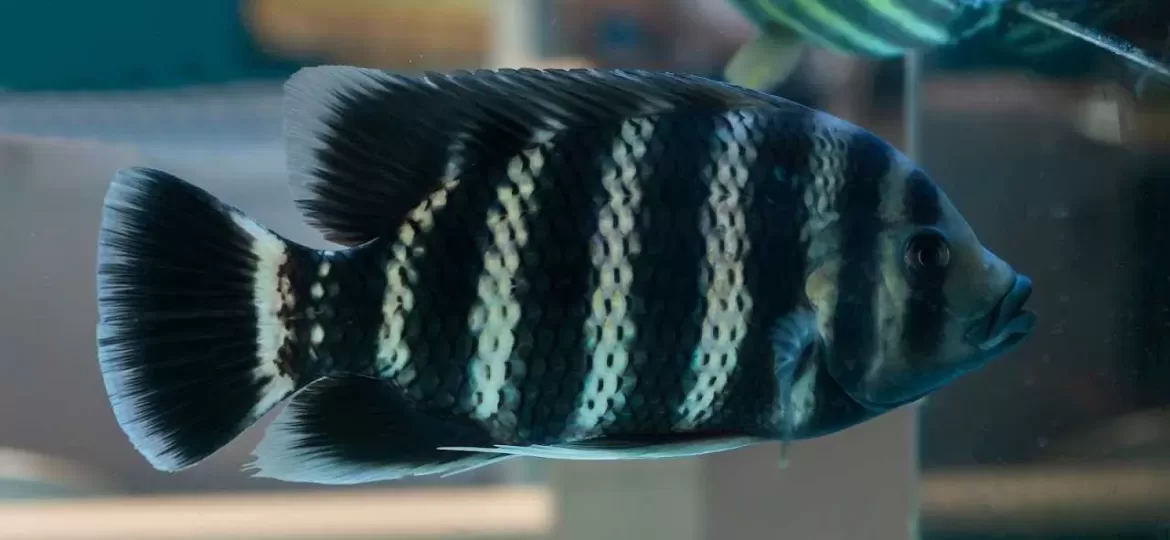
The Zebra Tilapia or Tilapia buttikoferi are members of the family Cichlidae more commonly referred to as cichlids. They inhabit the rivers and streams of Liberia in West Africa.
Zebra tilapias have a pale yellow or off white body with vertical black striping from the region to their eyes to the base of their tale. They are also referred to by the names of other striped animals such as hornet or tiger tilapia. Their stripes will actually change shade according to their mood. They will vary from very light to nearly black. The vertical markings tend to fade as the fish grows older.
The zebra tilapia is a larger species of cichlid. They commonly grow up to 16 inches in length. A similarly sized aquarium will be necessary if you intend to raise them. A 75 gallon tank is the minimum recommendation. These fish are mid-level swimmers.
Zebras are one of the most vicious members of the cichlid family. They are best suited for a mono-species tank. They are so territorial that it is not recommended that you attempt to raise them in a group. These fish should be kept as a single fish or a couple only. Despite their innate aggressive behavior they are still reasonably popular with aquarium owners. This is because they are very intelligent creatures.
They are acutely aware of their surroundings. They react to movement outside of their aquatic environment. They often feel their territory is being invaded by a person in the same room will attempt to attack the intruder trough the glass. They are also known to wreak havoc on aquarium substrate. These are substrate breeders and have a tendency to dig up gravel even when they are not in the spawning cycle. They will suck up a mouth full of gravel and spit it out somewhere else creating little hills and valleys in the aquarium floor.
These fish are also very long lived. They will live an average of 10 years and have been known to live as long as 15.
Water temperature should be between 74-78 °F with a slightly alkaline pH.
They are omnivores, so provide them with both meaty and plant-based foods.
Young Tilapia can be fed tropical fish flakes, cichlid pellets, frozen or freeze-dried foods. They will also brine shrimp, tubifex and bloodworms. When they get bigger you can feed them small shrimp, crickets and earthworms. Tilapias are not picky eaters. They will eat their veggies. In fact they have an affinity for blanched vegetables such as lettuce, zucchini and even broccoli. Just throw the veggie of choice in a pot of boiling water for 15-20 seconds, remove the vegetables and let cool. Don’t expect to keep live plants with a talpiia. If they have a tasted for the plant they will eat it. If they don’t they are apt to dig it up. Because of their size they also produce a lot of waste. Frequent water changes are needed in order to keep them healthy.
Male and females are virtually identical. So you may not be able to tell them apart until they spawn.
Breeding Tilapia
As mentioned earlier, zebras are substrate spawners. They tend to mate in private so you will want to provide them with upturned plant pots or some other form of artificial cave. A slight increase in water temperature indicates spawning season and may induce them to spawn.
They will usually dig a hole in the substrate to deposit their eggs in. However they have been known to lay their eggs on the roof of the mating chamber. Both parents generally care for the young. Though spawning may trigger aggressiveness in the male. If this occurs remove the male and allow the female to tend her eggs.
Fry typically hatch in 4-5 days and will become free swimming in another 5 or 6. Fry can be fed newly hatched brine shrimp, liquid or powdered fry food formulated for egg layers.
AUTOPOST by BEDEWY VISIT GAHZLY







